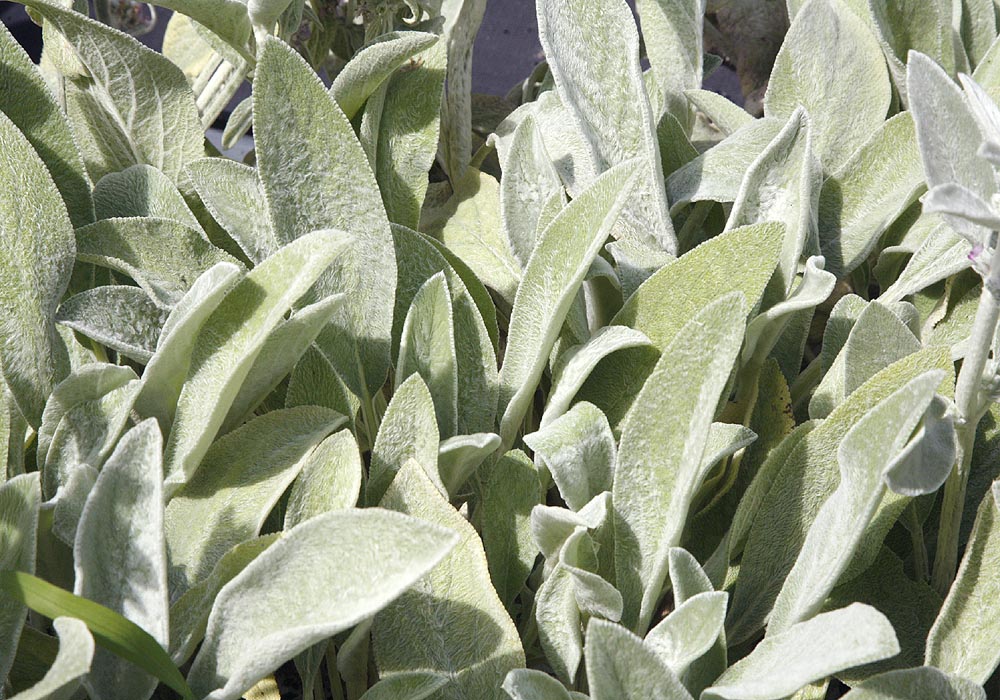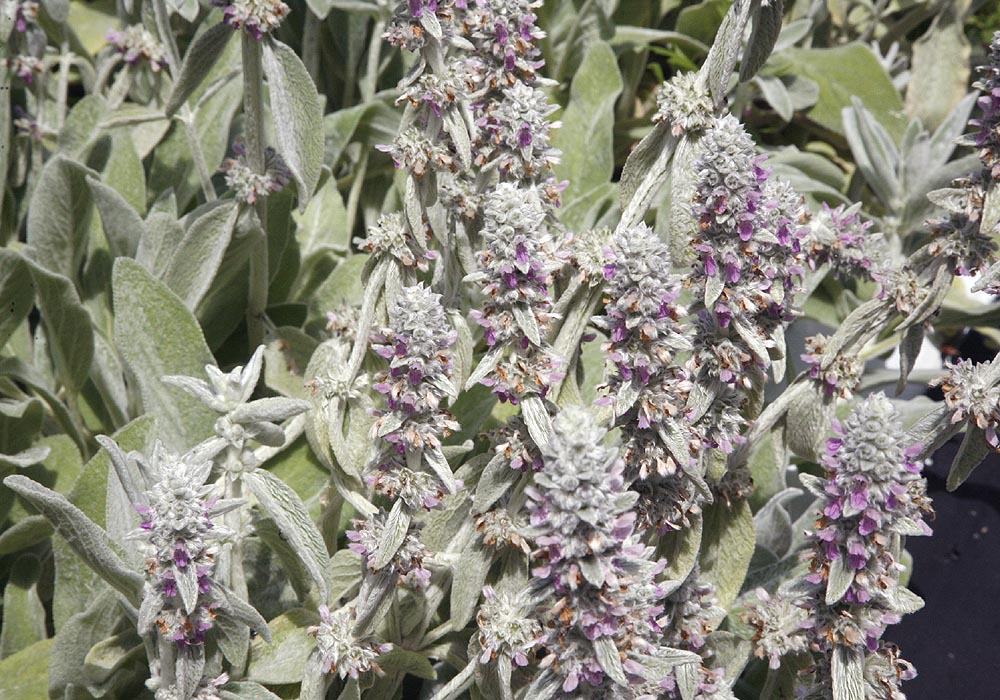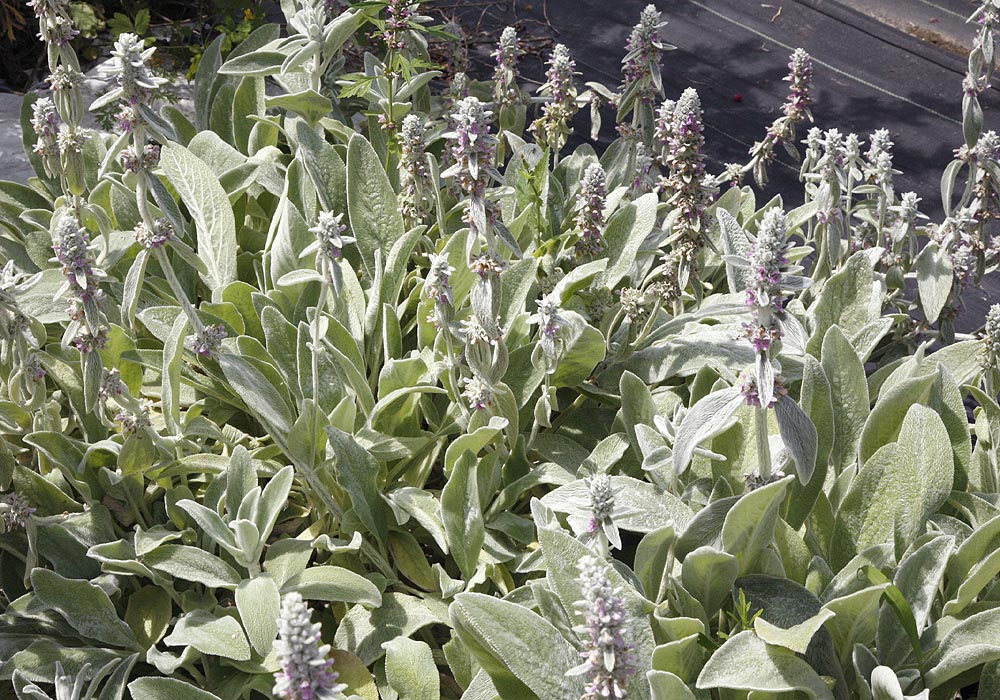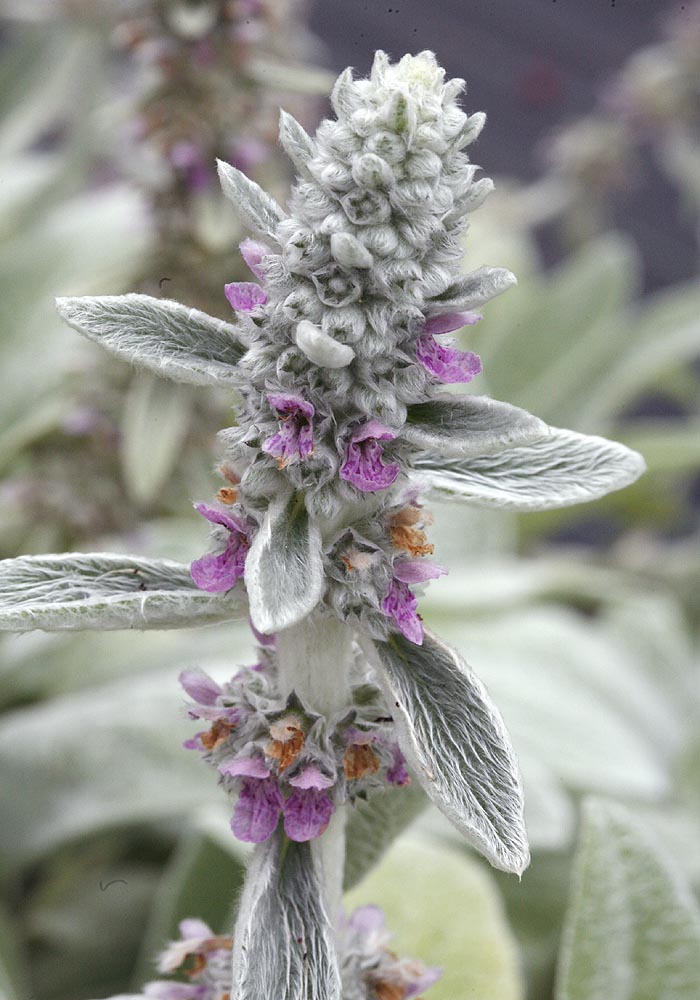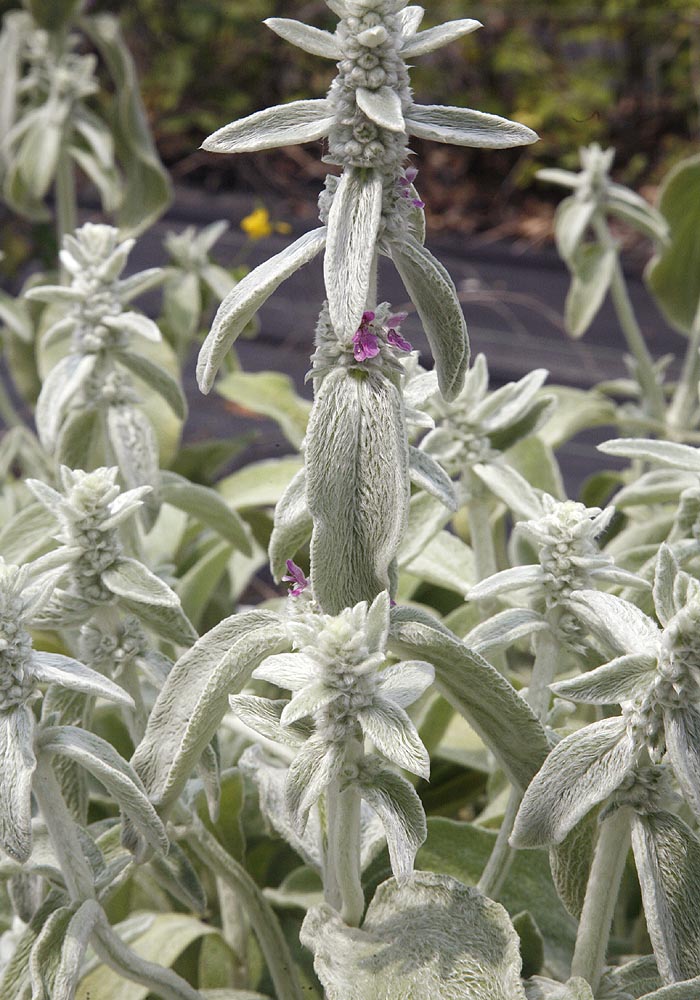A perennial plant that is grown for its foliage more than its flowers. Lambs
ear is a must for almost any cool weather garden. Hardy to zone 4 it will be
evergreen in warmer zones. It forms a beautiful silvery ground cover in sunny
well drained areas. It is very drought tolerant and needs very little care once
established. Will thive in hot sunny rock gardens and places where other plants
have a hard time. Deer and rabbits don't eat it making it an ideal garden
plant.
The purple flowers are interesting but its really the lovely soft silvery folage
that is the attraction of this plant. Can be grow in planters and used under
trees and shrubs as long as it gets good sunshine. Does not tolerate humid conditions
well so not a good choice for hot humid southern gardens. There is can be grown
as a winter annual.
The silvery foliage shines well by moonlight and helps lighten smaller gardens
or areas where more light is desired. Once it spreads out it takes over the
ground so no care or weeding is required. Just enjoy.
Description of Lambs Ear (Stachys byzantina).
A hardy perennial that is evergreen in warmer zones. Above zone 7b it tends
to die down in winter but comes back quickly in spring. It is low growing with
long elliptic leaves that are densely covered in fine silvery wool-like hairs.
The heaves are tough and wrinkled with a fine wavy toothed (crenate) edge. Leaves
can be 2-4" (5.1-10.2 cm) long, and about 1" (2.5 cm) wide and are
blue green in color. They form in basal rosettes that will spread slowly outward
increasing the plants width. In early summer it sends up tall white stalks that
reach 18" (46 cm) with pairs of leaves at wide intervals and topped with
a cone shaped woolly mass of tightly packed flower heads that open a few at
a time with small purple flowers. Flowering can last several weeks, but are
mainly a bonus for the beautiful foliage.
Growing Lambs Ear (Stachys byzantina) from Seed.
Very easy plant to grow from seed, just do not cover the seeds. They need light
to germinate.
Best started indoors in either trays or pots. Sow thinly and follow our general
growing instructions for seeding and seed care. Sow 8-10 weeks before last
frost for best results. Germination in 15 - 30 days depending on temperature.
Can also be sown outdoors in desired location after all danger of frost has
passed. Prepare bed remove all weeds and work bed to a fine soil, spread seeds
thinly then press down with hands to firm them into good soil contact. Do not
cover seed. Water regularly and keep moist until seeds germinate. Plants can
then be thinned if desired.
Seeds can also be sown in late fall early winter for early spring start.
Location and Care of Lambs Ear (Stachys byzantina).
Lambs ear is a plant for cooler zones 4 -7a. It likes full sun and a well drained
soil. It will grow in almost any soil that is not waterlogged but its tolerance
for heat and dry make it idea for rock gardens, planters that tend to be forgotten
and ground cover in hot dry areas.
Warmer zones it will depend on your climate. If you have a hot dry climate
then lambs ear may do OK. It's the humidity that it cannot tolerate. Having
the fuzzy leaves a benefit in cooler zones or when overnight temperatures drop
such as semi desert conditions. However in the heat they trap the moisture and
make the plant too wet. It then succumbs to root rot, powdery mildew and other
diseases. If desired in can be grow as an cold season annual in hotter climates
but will most likely die in the hot humid summer weather.
In areas where is does well it prefers a sunny location, while it can tolerate
some shade it is only a little. Likes sandy well drained soils best but will
tolerate anything that does not waterlog at any time. If you have more clay
then amend your soil by adding plenty of well composted organic material before
planting.
Space plants about 16" apart. They will soon establish and spread out to
fill the gaps. Once the ground is covered they tend to beat out any weeds and
form a perfect mat of silver foliage.
Flower stalks may be removed after flowering to enhance the look of the foliage
but otherwise the plants need little care once established.
Watering. In areas where there is little rainfall or during drought some
supplementary water is good. If possible use a soaker hose on the ground and
not on the foliage to discourage any humidity build up that could cause leaf
diseases. Water in the morning so that the sun has time to burn off leaf water
during the daytime.
If your climate is particularly wet plant in a very well drained area to help prevent leaf rot.
In ideal locations it will establish quickly and spread, make sure you give it enough room, plant only in areas where you want it to cover the ground. It will crowd out any other smaller plants that are around it. Plant under larger shrubs or flowering plants such as roses or border on trees that get full sunshine. It may need chopping back if it begins to invade other areas.
Planters. Lambs ear is great in planters especially around the base of larger trees but also alone as long as it gets full sun. easy to maintain and water. Needs little care.
Moon Gardens.
Lambs ear is a real favorite in moon gardens. These are gardens that are appreciated
at night, so the silvery foliage shines well in moonlight.
Harvesting of Lambs Ear (Stachys byzantina).
The flowering stalks of this plant can be dried for autumn arrangements. Simply
cut it off close to the base of the plant when the head is in full bloom and
hang it upside down to dry. Leaves may also be dried and used (air dry). Moisture
in the air can cause the heads to droop sometimes, so best used lying horizontal,
or plan the shape of the arrangement accordingly.
Lamb's Ear takes its name from the shape and texture of its foliage, and this
is the appeal of the plant, though it does bloom as well. (The flowers are pale
purple, carried on spikes above the foliage, and not particularly breathtaking!)
This perennial forms a nice rosette with long, elegant leaves in all directions.
Culinary Uses of Lambs Ear (Stachys byzantina).
There are reports of the young leaves may be eaten in salads or gently steamed
as greens.
Medical uses of Lambs Ear (Stachys byzantina).
The leaves have antibacterial, antiseptic, and anti-inflammatory properties
as well as aiding in blood clotting. For this reason they were once widely used
for wound dressings on battlefields.
A tea made from the young leaves is used to treat fevers, diarrhea, sore mouth
and throat, internal bleeding, and weaknesses of the liver and heart. The same
tea can be used topically as an eyewash to treat pinkeye and sties
The juice from crushed leaves can be placed directly on the skin to treat bee
stings and insect bites helping to reduce swelling. It can also be used to treat
hemorrhoids, or for postpartum recovery
Other uses of Lambs Ear (Stachys byzantina).
Some reports of using the super soft and possibly absorbent leaves as a substitute
for toilet paper while backwoods camping have been reported. Perhaps, but the
leaves are fairly small and don't grow in the wild apart from in their native
range so this may be a wishful exaggeration.
Other facts
Lambs ears is originally native to Turkey, Armenia, and Iran.






